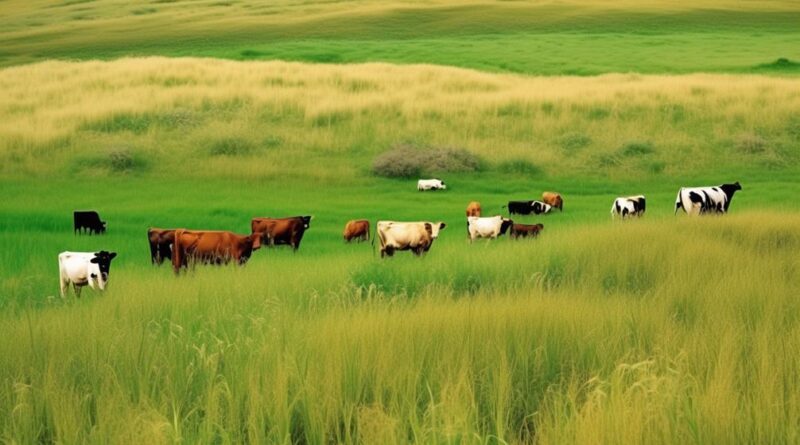10 Key Practices for Sustainable Beef Production With Regenerative Grazing
You're standing at the edge of a vast, open field, the earth beneath your feet teeming with life and potential.
As you look out across the expanse, it's not just the sight of grazing cattle that captures your attention, but the intricate dance of sustainability and regeneration taking place.
Imagine if there were 10 key practices that could unlock the full potential of this landscape, ensuring not only the production of high-quality, sustainable beef but also the restoration of the land itself.
These practices go beyond traditional farming methods, offering a holistic approach to beef production that benefits the environment, the animals, and the community.
Holistic Grazing Management
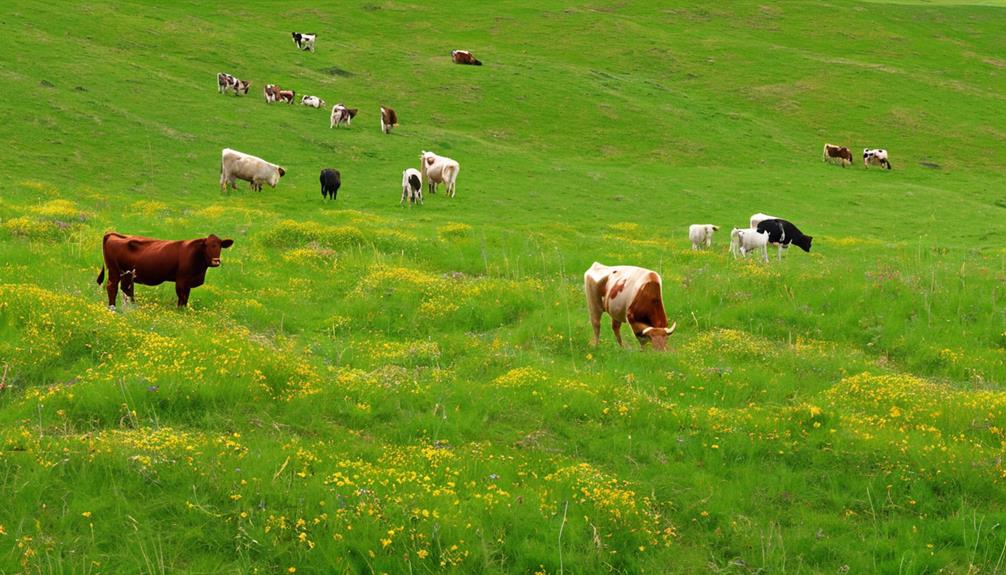
To improve the sustainability of your beef production, implement holistic grazing management practices that prioritize the health of your livestock and the land they graze on. By integrating regenerative grazing techniques, you can enhance the overall health and productivity of your grazing land. Regenerative grazing techniques focus on mimicking the natural grazing patterns of wild herbivores, allowing for proper rest and recovery periods for the land. This approach promotes biodiversity, soil health, and carbon sequestration, all of which contribute to the long-term sustainability of your beef production.
Grazing land rehabilitation is a key component of holistic grazing management. By carefully planning the movement of your livestock and implementing rotational grazing, you can prevent overgrazing in specific areas while allowing for rest and recovery. This not only benefits the land but also enhances the overall health and well-being of your livestock. As your cattle graze on diverse forage, they receive a well-rounded diet, leading to improved health and potentially reducing the need for supplemental feed.
Implementing these holistic grazing management practices requires careful observation and planning. By monitoring the condition of your grazing land and the health of your livestock, you can make informed decisions to ensure the long-term sustainability of your beef production. Additionally, integrating these practices can contribute to a more resilient and productive grazing operation, benefiting both your business and the environment.
Rotational Grazing Systems
Implementing rotational grazing systems builds on the principles of holistic grazing management, allowing for strategic land use and optimal livestock health. Rotational grazing involves dividing pastures into smaller paddocks and rotating livestock through them at strategic intervals. This practice offers several benefits, including improved forage utilization and grazing intensity.
With rotational grazing, livestock are moved to a new paddock once the forage in the current paddock has been sufficiently grazed. This allows forage in previously grazed areas to recover, leading to improved forage utilization. As a result, the overall carrying capacity of the land can be increased, as forage plants have more time to regrow before being grazed again.
Furthermore, rotational grazing helps regulate grazing intensity. By controlling the duration and frequency of livestock grazing in specific areas, this system prevents overgrazing and promotes more uniform utilization of forage across the pasture. This not only benefits the health of the forage plants but also contributes to balanced diets for the livestock.
In addition, rotating livestock through different paddocks helps disperse manure more evenly across the pasture, enhancing nutrient distribution and soil fertility.
Soil Health Improvement
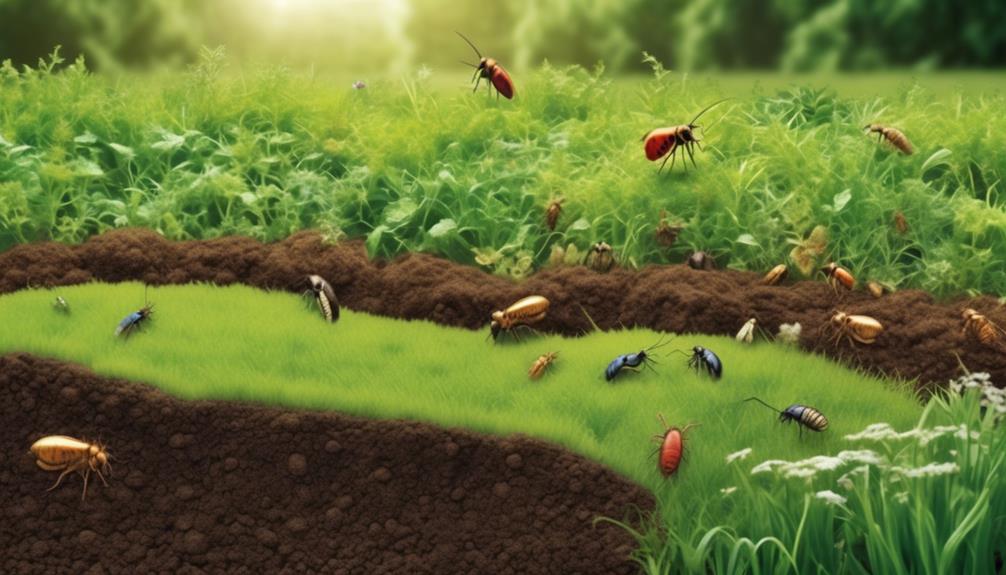
You can enhance soil health by incorporating sustainable farming practices that prioritize nutrient cycling and organic matter decomposition. By implementing regenerative grazing techniques, you can improve soil fertility and overall soil health.
In a regenerative grazing system, livestock are rotated through different pasture areas, allowing forage plants to recover and the soil to replenish its nutrients. This rotational grazing approach promotes nutrient cycling as the animals' grazing and trampling actions encourage plant residue decomposition, which in turn enriches the soil with organic matter. This organic matter serves as a source of nutrients for soil microorganisms and promotes soil structure, water retention, and overall fertility.
Additionally, incorporating cover crops into your grazing system can further enhance soil health. Cover crops such as legumes or grasses help prevent soil erosion, suppress weed growth, and improve soil structure. Moreover, these cover crops contribute to nutrient cycling by adding organic matter to the soil when they're terminated or grazed by livestock.
Furthermore, minimizing the use of chemical fertilizers and pesticides can also contribute to soil health improvement. These synthetic inputs can disrupt the natural balance of soil microorganisms and reduce nutrient cycling processes. Instead, focus on natural fertilization methods and integrated pest management practices to maintain a healthy and thriving soil ecosystem.
Biodiversity Conservation
Enhance the natural habitat of your grazing area to promote the conservation of diverse plant and animal species. By implementing conservation initiatives, such as habitat restoration and species protection, you can contribute to the preservation of biodiversity while achieving sustainable beef production.
Conserving biodiversity is essential for maintaining ecosystem balance and resilience, as diverse plant and animal species play crucial roles in supporting the overall health of grazing lands.
To promote biodiversity conservation, consider implementing habitat restoration practices that mimic natural ecosystems. This may involve reintroducing native vegetation, creating wildlife corridors, and restoring wetlands or riparian areas. By enhancing the natural habitat, you provide a conducive environment for a variety of species to thrive, contributing to the overall health and resilience of the ecosystem.
Species protection is another vital aspect of biodiversity conservation. Identify and prioritize the protection of endangered or threatened species within your grazing area. This may involve implementing measures to minimize disturbances to their habitats, such as avoiding grazing during sensitive periods or designating protected areas.
Conserving biodiversity not only supports the health of the natural environment but also provides long-term benefits for sustainable beef production. A diverse range of plant species can contribute to improved forage quality and quantity, while diverse animal species contribute to natural pest control and nutrient cycling. By actively promoting biodiversity conservation, you can create a more resilient and productive grazing ecosystem.
Water Management Strategies
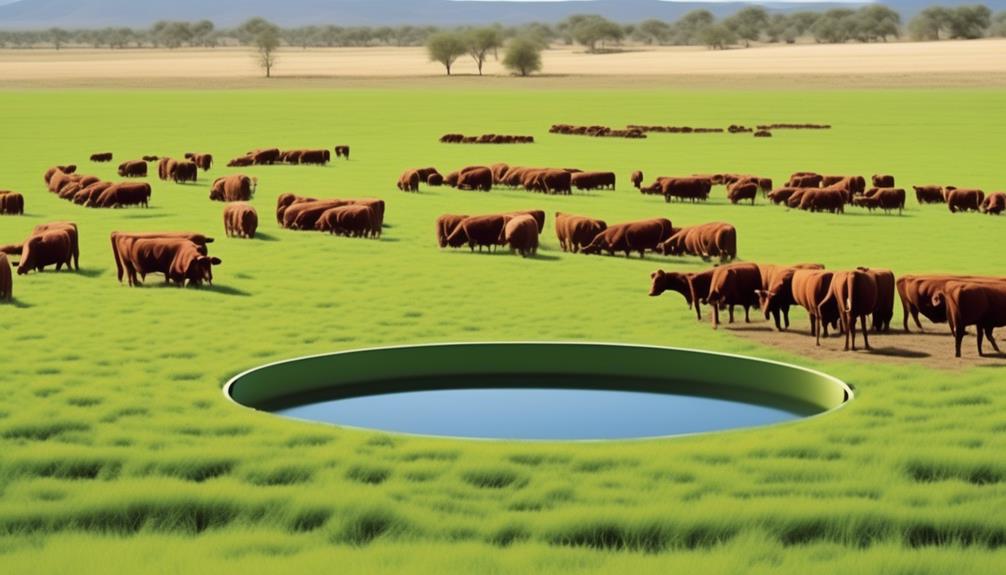
To ensure efficient water management in beef production, consider adopting sustainable irrigation practices to optimize water usage and preserve natural resources.
Sustainable irrigation methods such as drip or micro-irrigation systems can significantly reduce water waste by delivering water directly to the roots of plants, minimizing evaporation and runoff. These techniques not only conserve water but also promote soil health and reduce the risk of erosion, aligning with the principles of conservation agriculture.
Conservation agriculture emphasizes the importance of maintaining soil health, reducing erosion, and preserving water resources. By implementing practices such as minimal tillage, cover cropping, and crop rotation, you can enhance water retention in the soil, reduce the need for irrigation, and promote sustainable water management in beef production. These methods not only contribute to efficient water use but also support the overall health of the ecosystem.
Additionally, integrating water-efficient pasture management strategies can further optimize water usage in beef production. Rotational grazing, for example, allows for better control over water distribution, as it prevents overgrazing in specific areas and promotes more uniform grass growth. This approach supports sustainable irrigation by ensuring that water resources are utilized effectively and that pastures remain resilient to changing environmental conditions.
Carbon Sequestration Techniques
Implementing effective carbon sequestration techniques is crucial for reducing the environmental impact of beef production and mitigating greenhouse gas emissions. Carbon offsetting plays a significant role in sustainable beef production, allowing for the reduction of emissions through activities such as grassland restoration and regenerative agriculture. By sequestering carbon in grasslands, you contribute to ecosystem resilience and support regenerative agriculture practices.
Grassland restoration is a key carbon sequestration technique that involves the reestablishment of native grasses and plants, which enhances the soil's ability to capture and store carbon. This process not only mitigates the carbon footprint but also fosters biodiversity and improves the overall health of the ecosystem. By actively participating in grassland restoration, you can play a vital role in enhancing carbon sequestration while promoting sustainable land management.
In addition to grassland restoration, regenerative agriculture practices are essential for carbon sequestration. These practices focus on enhancing soil health, increasing organic matter, and minimizing soil disturbance, all of which contribute to carbon sequestration. By adopting regenerative agriculture techniques such as rotational grazing and cover cropping, you not only sequester carbon but also improve the resilience of the entire ecosystem.
Animal Welfare Practices
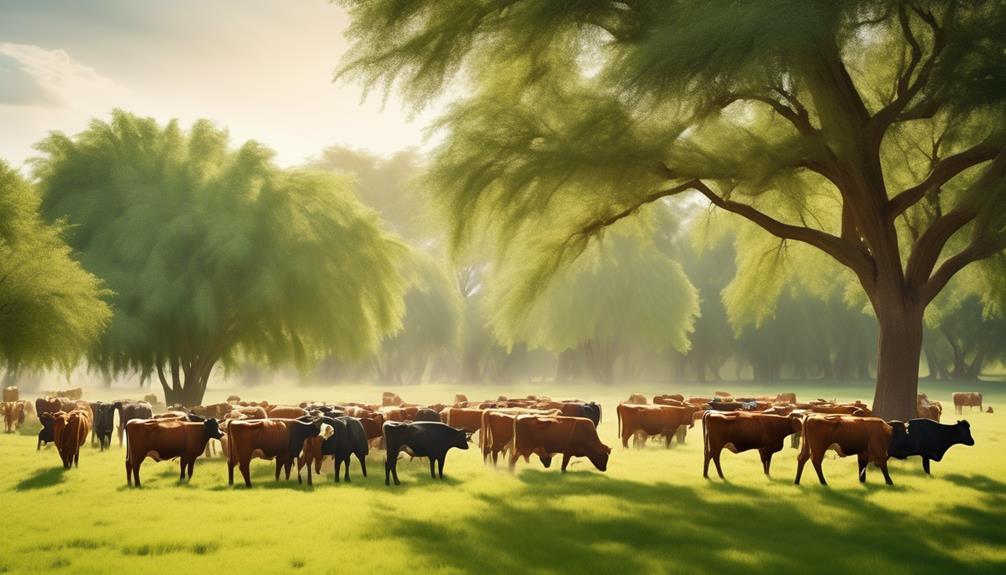
After understanding the crucial role of carbon sequestration techniques in sustainable beef production, it's important to prioritize animal welfare practices to ensure the overall well-being of livestock in the industry.
Embracing animal welfare standards and ethical treatment is fundamental to maintaining a sustainable and ethical beef production system. When considering animal welfare practices, it's crucial to focus on grazing behavior and stress reduction to ensure the well-being of the livestock.
- Animal Welfare Standards and Ethical Treatment
Implementing and upholding high animal welfare standards ensures that livestock are treated with respect and care, aligning with ethical practices. This involves providing proper living conditions, access to clean water, and appropriate nutrition to maintain the health and well-being of the animals.
Ensuring ethical treatment involves handling livestock with care and empathy, minimizing stress, and avoiding any form of mistreatment. By prioritizing the ethical treatment of animals, producers can create a positive and sustainable environment for their livestock.
- Grazing Behavior and Stress Reduction
Understanding grazing behavior is essential for promoting natural habits in livestock. Providing ample access to pasture and open spaces allows animals to exhibit their natural grazing behaviors, contributing to their overall welfare.
Implementing practices that reduce stress in livestock, such as providing shelter from extreme weather conditions and minimizing handling-related stress, is crucial for maintaining animal welfare in beef production.
Community Engagement and Education
Engage the local community by organizing educational programs on sustainable beef production practices to promote understanding and collaboration.
Outreach programs and educational workshops are essential for fostering a shared understanding of regenerative grazing and its positive impact on the environment and beef production. By involving the local community in these educational initiatives, you can build stronger relationships and create a network of support for sustainable beef production.
One effective way to engage the community is by hosting outreach programs that bring together farmers, ranchers, and local residents. These programs can include field days, farm tours, and workshops that provide hands-on experience and knowledge sharing. By participating in these events, community members can gain a deeper appreciation for the role of regenerative grazing in sustainable beef production.
Educational workshops also play a crucial role in community engagement. These workshops can cover topics such as soil health, rotational grazing, and the benefits of regenerative practices. By providing practical information and resources, you can empower community members to adopt sustainable beef production practices on their own farms and properties.
In addition to educating the local community about sustainable beef production, these initiatives can also create opportunities for collaboration and knowledge exchange. By fostering a culture of learning and cooperation, you can work together with the community to promote the long-term viability of regenerative grazing and sustainable beef production.
Frequently Asked Questions
How Can Regenerative Grazing Practices Benefit Local Economies and Communities?
By engaging with the community and implementing regenerative grazing practices, you can boost local economies and create jobs. This sustainable approach to beef production promotes economic development while fostering a sense of community involvement and support.
What Are Some Potential Challenges or Barriers to Implementing Regenerative Grazing Practices?
Implementing regenerative grazing practices can pose challenges such as high initial costs, resistance to change, and lack of knowledge. These barriers can hinder sustainability efforts and have a negative environmental impact if not addressed effectively.
Are There Specific Breeds of Cattle or Other Livestock That Are Better Suited to Regenerative Grazing?
When considering cattle breeds and livestock suitability for regenerative grazing, look for those that thrive in diverse forage environments. They can help improve soil health and provide ecological benefits by promoting biodiversity and natural ecosystem balance.
How Do Regenerative Grazing Practices Impact the Nutritional Quality of Beef Products?
Regenerative grazing enhances beef's nutritional quality, meeting consumer demand for healthier products. It also fosters environmental sustainability by improving soil health, biodiversity, and carbon sequestration. These benefits make regenerative grazing a win-win for both consumers and the environment.
What Are Some Innovative Technologies or Tools That Can Support Regenerative Grazing Practices?
Innovative technologies like precision livestock management systems and soil health monitoring tools can greatly support regenerative grazing practices. They play a crucial role in enhancing soil health, managing livestock, and promoting carbon sequestration.
Conclusion
In conclusion, by implementing these 10 key practices for sustainable beef production with regenerative grazing, you can:
- Improve soil health
- Conserve biodiversity
- Manage water effectively
- Sequester carbon
- Ensure animal welfare
Engaging with your community and educating others about these practices is also important for long-term success. By making these changes, you'll contribute to a more sustainable and regenerative approach to beef production, benefiting both the environment and future generations.
